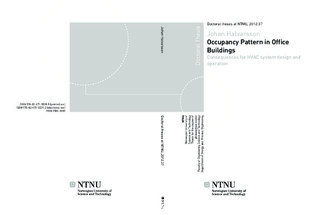| dc.description.abstract | The main objectives with the work presented in this thesis have been: (a) to contribute to an increased understanding of the consequences that the occupancy pattern can have on the indoor climate and for Heating, Ventilation and Air Conditioning (HVAC) system design and operation; and (b) to investigate how typical occupancy patterns can look like in office buildings.
The occupancy pattern in an office is a function of the floor layout of the building, and the user organisation(s) occupying it and their way of working. The combination of these two, will decide how the users occupy the building, which in turn is an important design prerequisite/constraint for the HVAC system design process. There are many assessments related to indoor climate and HVAC that involve considerations of the occupancy pattern, reaching from estimates of internal heat and pollution loads to deciding on an appropriate control strategy of HVAC systems, or estimating the energy saving potential with demand controlled ventilation.
A few numerical measures have been used to describe different aspects of the occupancy pattern. The zone based occupancy factor (OFz) expresses the ratio between the number of occupied sub-zones/rooms in a zone and the total number of sub-zones/rooms in the zone. OFz does not take the number of people into account, only whether a sub-zone/room is occupied or unoccupied. OFz can be used both to express instantaneous occupancy levels and averages over time. Superscript is used to specify the time, or time period, that the measure refers to. For instance, 06 18,wd OFz _ means the average OFz between 6 a.m. and 6 p.m. on working days, while the 95th percentile of OFz6_18,wd , means the 95th percentile of all instantaneous values (one or five minute averages in the case studies) of OFz that have occurred during the same time period. The utilisation rate (UR) expresses the fraction of time that a room is occupied, within a specific time period.
It is important to distinguish between the actual occupancy state of a room (occupied or unoccupied) and the detected occupancy state, which is the one monitored in case buildings presented in this thesis. The detected occupancy state can differ from the actual occupancy state, because of false-detection and time-delay of the detector. The OFF-delay (TD-OFF) is the time from the last detected motion occurred until the detector changes the output signal, and the zone is recorded as unoccupied in connection with logging. It is however possible to make some corrections regarding TD-OFF to estimate the actual occupancy levels.
Based on a literature study, it can be concluded that there is a need for more empirical basic data on occupancy in offices, with measurements from a wide spectre of organisations. In particular, detailed data describing variations between zones/rooms in one and the same building and short- and long-term fluctuations are very limited. In addition, there is a lack of data on peak, or close to peak, occupancy rates, relevant for HVAC system design.
Occupancy has been monitored in room samples from eleven organisations in five Norwegian office buildings. The data set contained 247 office cells and 16 meeting rooms. The case studies indicated that 06 18,wd OFz _06 18,wd with 20 minutes TD-OFF and actual occupancy during working hours ( 8 17,wd OFz _8 17,wd) for one-person cellular offices is on average around 0.4, and somewhere between 0.2 and 0.6 for most Norwegian organisations. There is a large variation in utilisation rates for meeting rooms, with UR6_18,wd ranging from 0.1 to 0.7. Furthermore, the case studies indicate that in a zone with more than 10 office cells, we can expect roughly the following close to peak levels of OFz6_18,wd , with 20 minutes TD-OFF: between 0.5 and 1.0 for the 98th percentile and between 0.45 and 0.95 for the 95th percentile. | nb_NO |
